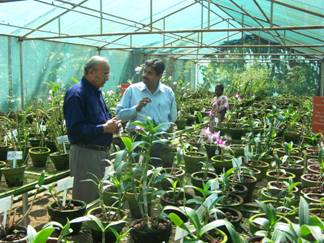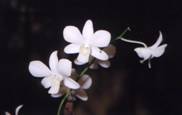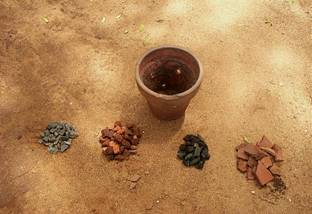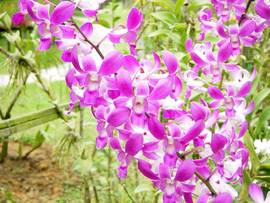DENDROBIUM ORCHID (Dendrobium sp.)
Orchidaceae
Dendrobium species is a typical tropical orchid species suitable for Chennai and other coastal areas where the humidity is high.

Dendrobium cultivation under shade net
Varieties
Sonia 17, Sonia 28, Emma White, Sakura Pink. .

|

|

|
Sonia-17 |
Sonia- 28 |
Pravit white |
Climate
75% green shade net with 70 - 80% humidity, 18 - 28ºC temperature and light intensity of 1500-2000 foot candles is ideal for growing this tropical orchid.
Growing environment:
75% shade net house with 70- 80% humidity, day temperature of 21 - 29oC and night temperature of 18 to 21oC is ideal for growing this tropical orchid. In high rainfall zones, the shade net house should be provided with a rainshelter.
Propagation:
Division of clumps, keikis, back bulbs and tissue culture plants.
Containers and support : perforated earthen pots are ideal and the plants are staked with bamboo sticks.

T C PLANTS
Growing media:
Most common potting mixture consists of charcoal, broken pieces of bricks and tiles, coconut husk and fiber.

Growing media
Irrigation:
Mist or overhead sprinkler to provide water and to maintain humidity.
Nutrients:
Foliar application of NPK 20:10:10 @ 0.2% at weekly intervals starting from 30 days after planting.

Foliar feeding of NPK - 17:17:17 complex
Growth regulators
Foliar application of GA3 50 ppm at bimonthly intervals starting from 30 days after planting.
Repotting
Orchids need repotting regularly, usually every two to three years.
1. When the plant grows large and overgrows its container.
2. When the potting material deteriorates
3. When the plant has to be split or divided
4. It is better to repot epiphytes every year.
The best time for repotting is when fresh roots emerge at the bases of the previous year’s growth. In monopodial climbers, repotting or division has to be done when new leaf growth shows at the top and there is new root growth.
Splitting or division of plants
Plant grown to a large clump with 2 or 3 old canes and new shoots, - divided before repotting. Each division - at least one old cane of two years’ growth, one new shoot & some new roots.
Pests:
Snail and slug: Hand pick and destroy
Harvest
Dendrobium flower fully matures only 3 or 4 days after it opens. Flowers are harvested when they are fully open as the flowers cut prior to their maturity will wilt before reaching the wholesaler. Immediately after harvest, the lower 0.75cm of the peduncle is cut off, and the flower is inserted into a fresh tube of water containing preservative. Harvesting the spike when 75 per cent of the flowers are open and remaining buds are unopen.

Spike ready for harvest
Post harvest handling:
| Pulsing |
: |
8-HQC 500 ppm + Sucrose 5% for 12 hrs |
| Holding solution |
: |
AgNO3 25 ppm + 8-HQC 400 ppm + Sucrose 5% |
| Wrapping material |
: |
50 gauge polythene with base of spikes dipped in 8-HQC
25 ppm |
Yield:
8 - 10 spikes/plant/year
Pests:
Snail and Slug:
Hand pick and destroy them immediately.
Diseases:
1. Bacterial soft and Brown rot (Ervinia spp.)
Foliar application with Streptomycin Sulphate @ 0.5 g + Copper Oxy Chloride @ 2 g/l.
2.Bacterial Brown spot (Acidovorax sp.)
Foliar application with Streptomycin Sulphate @ 0.5 g + Copper Oxy Chloride @ 2 g/l.
3. Blackrot (Pythiumsp.and Phytothora sp.)
Foliar application of Metalaxyl 2 g / lit. (or) Dimethomorph 50% WP 0.5 g / lit.
4. Anthracnose – Foliar application of Thiophanate Methyl 2 g / l (or) Difenoconazole 0.5 ml/l
Source:
1. http://www.everbloomorchids.com/images/EverBloom-Orchids-Red-Dendrobium.jpg
2. www.rafflesgalleria.com/orchid-dendrobium.html |








